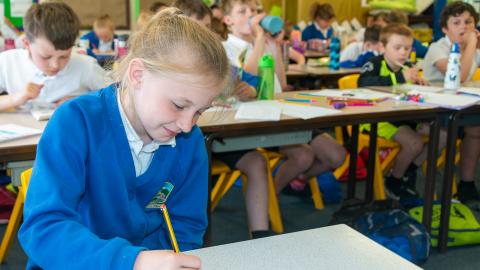Writing
Curriculum Intent and Aims
In English, at Settle Primary School, our main aim is for all children to develop a love of reading, writing and discussion. One of our priorities is helping children read and develop their all-important comprehension skills. We recognise the importance of nurturing a culture where children take pride in their writing, can write clearly and accurately, and adapt their language and style for a range of contexts. We want to inspire children to be confident in the art of speaking and listening and who can use discussion to communicate and further their learning.
We believe that children need to develop a secure knowledge-base in Literacy, which follows a clear pathway of progression as they advance through the primary curriculum. We believe that a secure basis in literacy skills is crucial to a high-quality education and will give our children the tools they need to participate fully as a member of society.
Planning and Resources – A Mastery Approach
The English curriculum at Settle Primary has taken many of the content and principles of ‘Mastery’ in mathematics. We have developed a curriculum which ensures children spend longer being taught the common features and skills in reading and writing in order to have a more coherent English curriculum and therefore be able to develop mastery in English. The curriculum has been adapted using various methods such as: talk for writing, having a strong grammar focus, using high quality novels and books as well as using a range of drama conventions.
The Principles and Features Characterised in Our Curriculum:
- Teachers reinforce an expectation that all pupils are capable of achieving high standards in English.
- The large majority of pupils progress through the curriculum content at the same pace. Differentiation is achieved through additional support and encouraging children’s individual flair and fluency.
- Interventions focus on gaps in knowledge and developing a growth mind-set in order to ensure all children achieve.
- Teaching is underpinned by using high quality texts and high quality examples from the teacher which focus on skills to be taught. These texts are then analysed in depth with the children in order for them to learn and apply those skills.
- The teaching sequence of all texts are taught through a series of five phases in classes from Year 1 to Year 6 to ensure continuity and consistency for all children.
- Grammar and punctuation skills are practised and consolidated until all children have a firm understanding of how to apply them in their own work.
- Teachers use precise questioning in class to develop the children’s thinking and explanations, helping children to make literary choices in their writing.
Spelling Scheme
Key Stage 1
From Year 1, children are given weekly spellings to learn linked very closely to the graphemes they are taught in class through the Little Wandle programme. In Year 2, during autumn term 1, children revise Phase 5 of the Little Wandle phonics programme to consolidate learning from Year 1. From autumn term 2, children follow the Year 2 Little Wandle Spelling programme and have daily 30-minute lessons with weekly spellings to learn at home.
Key Stage 2
From Year 3 to Year 6, children are taught spellings through the Spelling Ninja scheme. All classes have 60 minutes of spelling practice each week. Children bring home weekly spellings.
Lesson Structure/Key Elements
English is taught in mixed ability groups for the majority of the time as we believe all children can achieve. In this approach, all children are exposed to some higher-level thinking questions and problem-solving as well as having the opportunity to collaborate and develop a growth mind-set through working with their peers.
Additional intervention is provided for children working below age expectations in reading and spelling along with extension activities and questions for children working at greater depth.
Teaching sequences for high-quality texts are taught through a phased approach:
- Prediction
- Comprehension
- Spelling, Punctuation and Grammar, and Text Organisation
- Drafting and Editing
- Publishing
Literacy working walls in all classes will follow this format for a consistent approach.
Marking
Where possible, marking is often done with the children in class and live feedback also used with class visualisers.
The title of each piece of work is a question linked to the lesson objective and will be highlighted green when achieved. Key features used within work will be unlined in green. Errors will be underlined in orange for children to correct with their purple pens. Written feedback is kept to a minimum. Where written feedback is provided (likely to be in draft and edit process), next steps will be given where necessary and a ‘target achieved’ stamp used when next steps are achieved.
Assessment
At the end of units of work, children in each class from Y1-6 are challenged to write an independent piece of writing. The writing is the assessed against the end points for the relevant term. Children will be set targets they need to work on for next steps.

